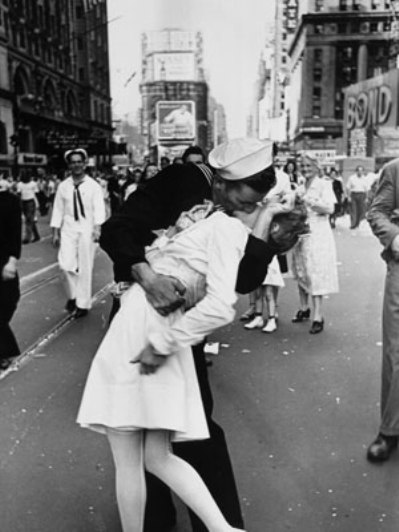It was August 14, 1945. It was VJ (Victory over Japan) Day. More than 750,000 people gathered in New York City’s Times Square to celebrate the Japanese surrender and the end of World War II.
Among the excited crowd was Edith Shain, a nursing school student, along with her roommate who had taken the subway to Times Square upon hearing the news that the war was over.
“We ran to Times Square because that’s where celebrations happen in New York City,” Shain said.
According to historical documents, the Times news ticker in Times Square went dark at 7 p.m. and then at 7:03 p.m., the crowd roared in jubilation as the words “OFFICIAL—TRUMAN ANNOUNCES JAPANESE SURRENDER” blazed across the news scroll.
Elated by the news, people in the crowd were embracing and hugging and crying tears of joy, but it was a far different experience for Shain.
“This sailor just grabbed me and kissed me,” she said. “Any female closes her eyes when she’s about to kiss so I never saw the guy, and then I walked away. I was kind of embarrassed. I didn’t say anything about it to anyone.”
While browsing a copy of a Life magazine a week later, Shain, then 27-years-old, recognized herself in what has became an iconic photo titled “V-J Day” (Victory over Japan) of a sailor slightly dipping a nurse in a white uniform and kissing her.
The famous photo was taken by Alfred Eisenstaedt, a photojournalist for Life Magazine. In his memoirs, Eisenstaedt explained that when he saw a sailor running along kissing any girl in sight, he ran ahead of the sailor while making sure to look back so that he wouldn’t miss anything.
When the sailor hit on a nurse whose white dress contrasted nicely with his dark suit, Eisenstaedt snapped the shot. But he failed to get their names. Coincidentally, another photographer, Victor Jorgensen, took the same shot from a slightly different angle and also forgot to get the subjects’ names.
Jorgensen’s version ran in the next day’s New York Times, but as a working military photographer at the time, he didn’t own the rights to his work. So while Eisenstaedt received glory and royalty checks for his image, Jorgensen simply got a nice clipping to hang on his fridge.
The photo was plastered all over newspapers and was seen as a symbol of a new era of peace, love and hope. The image became synonymous with the end of World War II and the sheer delight at being alive that many people felt.
The sailor in the photo has never been identified though about 20 men claimed to be the sailor in the famed photo.
Though Eisenstaedt died in 1995 at the age of 96 and Shain died on June 20, 2010 in Los Angeles at the age of 91, the celebrated picture has not lost its significance. The kiss captured by the photo has often been hailed the most iconic kiss in history.
 CY@CY Says Welcome to my dreamscape. Where a Lim is also a Ling.
CY@CY Says Welcome to my dreamscape. Where a Lim is also a Ling.
